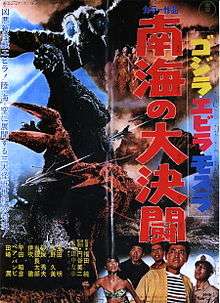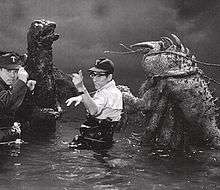Ebirah, Horror of the Deep
| Ebirah, Horror of the Deep | |
|---|---|
 Original Japanese poster | |
| Directed by | Jun Fukuda[1] |
| Produced by | Tomoyuki Tanaka[1] |
| Screenplay by | Shinichi Sekizawa |
| Starring |
Akira Takarada Kumi Mizuno Chotaro Togin Hideo Sunazuka Toru Watanabe Toru Ibuki Akihiko Hirata Jun Tazaki Ikio Sawamura Pair Bambi Eisei Amamoto |
| Music by | Masaru Sato[1] |
| Cinematography | Kazuo Yamada |
| Edited by | Ryohei Fuji |
Production company | |
| Distributed by | Toho |
Release dates |
|
Running time | 87 minutes[1] |
| Country | Japan |
| Language | Japanese |
| Budget | $1,200,000 |
Ebirah, Horror of the Deep (released in Japan as Godzilla, Ebirah, Mothra: Big Duel in the South Seas (ゴジラ・エビラ・モスラ 南海の大決闘 Gojira, Ebira, Mosura Nankai no Daikettō) is a 1966 Japanese science-fiction kaiju film produced by Toho. Directed by Jun Fukuda with special effects by Sadamasa Arikawa (supervised by Eiji Tsuburaya),[1][2] the film starred Akira Takarada, Akihiko Hirata, and Eisei Amamoto. The seventh film in the Godzilla series, this was the first of two island-themed adventure films starring Godzilla.
The film was released direct to television in the United States in 1967 by the Walter Reade organization as Godzilla vs. The Sea Monster.
Plot
After Yata (Toru Ibuki) is lost at sea, his brother Ryota (Toru Watanabe) steals a yacht with his two friends and a bank robber, the crew runs afoul of the giant lobster Ebirah, and washes up on the shore of an island, where a terrorist organization manufactures heavy water for their purposes, as well as a chemical that keeps Ebirah at bay. The organization, known as the Red Bamboo, has enslaved natives from Infant Island to help them, but the natives hope to awaken Mothra (now a full-grown moth metamorphosed from the larva that appeared in Ghidorah, the Three-Headed Monster) to rescue them.
In their efforts to avoid capture, Ryota and his friends, aided by a beautiful native girl, stumble across Godzilla sleeping within a cliffside cavern. The group devises a plan to defeat the Red Bamboo and escape from the island. In the process, they wake Godzilla using a lightning rod. Godzilla fights Ebirah, but the giant crustacean escapes. Godzilla is then attacked by Daikondura, a giant condor, and a squadron of Red Bamboo fighter jets, but destroys them.
The humans retrieve the missing Yata, free the enslaved natives and Godzilla begins to destroy the base. Godzilla smashes a tower that has a self-destruct button that makes the island unstable. Godzilla fights Ebirah and defeats it, ripping off both Ebirah's claws and causing it to retreat into the sea. The natives summon Mothra to save everyone, however, Godzilla challenges Mothra when she gets to the island. Mothra manages to push Godzilla away and carry the people off. Godzilla escapes the island just before it explodes.
Cast
- Akira Takarada as Yoshimura[1]
- Toru Watanabe as Ryota Kane[1]
- Toru Ibuki as Yata Kane (Ryota's Brother)[1]
- Chotaro Togin as Ichino[1]
- Hideo Sunazuka as Nita[1]
- Kumi Mizuno as Dayo[1]
- Pair Bambi as Mothra's priestesses[1]
- Jun Tazaki as Red Bamboo Commander,[1] one of the two primary antagonists of the film.
- Akihiko Hirata as Red Bamboo Captain Ryuui[1] (Yamoto in English version)
- Hideyo Amamoto as Red Bamboo Captain Naval Officer[1]
- Yutaka Sada as Farmer[1]
- Hisaya Ito as Red Bamboo Scientist[1]
- Tadashi Okabe as Red Bamboo Scientist[1]
- Chieko Nakakita as Mrs. Kane[1]
- Ikio Sawamura as Elderly Slave[1]
- Shoichi Hirose as escaped slave[1]
- Kazuo Suzuki as escaped slave[1]
- Wataru Omae as Islander
- Kenichiro Maruyama as Islander
- Haruo Nakajima as Godzilla
- Hiroshi Sekita as Ebirah
Production

The film was originally written as a King Kong film, titled Operation Robinson Crusoe, but Rankin/Bass Productions rejected the project, however, Toho proceeded with the project anyway and replaced King Kong with Godzilla.[3] Despite that Eiji Tsuburaya was given directorial credit for the special effects, Sadamasa Arikawa actually directed the special effects for the film under the supervision of Tsuburaya, who was busy with his own company, Tsuburaya Productions, at the time.[4] Toho had decided to set the film on an island in order to cut back on special effects costs.[5] Arikawa has cited the film as a frustrating experience, stating, "There were major limitations on the budget from the studio. Toho couldn't have made too many demands about the budget if Mr. Tsuburaya had been in charge. The studio knew I was also doing TV work then, so they must have figured I could produce the movie cheaply."[4]
The underwater sequences were filmed on an indoor soundstage where the Godzilla and Ebirah suits were filmed through the glass of a water-filled aquarium, with some scenes of the Godzilla suit shot separately underwater as well.[4] Haruo Nakajima (the suit performer for Godzilla) wore a wet suit under the Godzilla suit for every scene that required him to be in the water, which took a week to complete the water scenes, Nakajima stated, "I worked overtime until about eight o'clock everyday. Even though I wore a wet suit under the costume, I got cold. But I never got sick, because I was so tense during the filming."[4]
The US television version and early video versions have a different opening to the film. The opening scenes of Ryota at the Maritime Safety Agency searching for news of his brother have been replaced with a scene supposedly showing Ebirah destroying Yata's boat. This sequence was created by editing a later scene in the movie. The current DVD version of the film restores the Japanese cut.
In 1991, the film was distributed under the Film Ventures International name. The company replaced the opening with a generic credit sequence, using footage from Son of Godzilla. This version was aired on Mystery Science Theater 3000.
Release
Box office
In Japan, the film was released on December 17, 1966 and sold approximately 3,450,000 tickets. It was re-released on July 22, 1972 and sold approximately 760,000 tickets.
Walter Reade English version
In 1967, Continental Pictures released the film in a few theaters as Ebirah, Horror of the Deep[6] but the film was majorly released directly to television in North America by the Walter Reade Organization (who also released Ghidorah, the Three-Headed Monster) as Godzilla Versus the Sea Monster. It was the first Godzilla film to not receive North American theatrical distribution. The film was dubbed by Titra Studios in New York.[7]
There were several alterations made for this release:
- Captain Ryuui's name was changed to Yamoto. Ebirah and the Red Bamboo are never named.
- Deleted: The opening credits sequence. This version features only the title card, Godzilla versus The Sea Monster.
- Altered: 30 seconds of Ebirah's attack on the Yahlen were shifted to the beginning of the film, standing in for Yata's unseen shipwreck.
- Deleted: A scene where Ryota goes to the Maritime Safety office and sees a poster on the wall for a dance contest.
- Deleted: Yoshimura thinking up a plan with Nita and Ichino to turn the Yahlen around through cooperation with Ryota.
- Altered: The tracked in surf music from Akira Kurosawa's High and Low was removed during Godzilla's battle with the Red Bamboo airforce.
- Deleted: Several scenes of the natives of Infant Island praying to Mothra during the third act were removed.
The English version runs 83 minutes, four minutes shorter than the Japanese version. In 2005, Sony released the film on DVD for the first time in North America as Godzilla vs. The Sea Monster. This was also the first time the original Japanese version had been officially released on any format in the United States, however, the original Titra dubbed version was replaced with Toho's international English dub.
Home media
The film was released on DVD February 8, 2005 by Sony Pictures Home Entertainment. The film was released on Blu-ray on May 6, 2014 by Kraken Releasing.[8]
References
- 1 2 3 4 5 6 7 8 9 10 11 12 13 14 15 16 17 18 19 20 21 22 Stuart Galbraith IV (16 May 2008). The Toho Studios Story: A History and Complete Filmography. Scarecrow Press. p. 234. ISBN 978-1-4616-7374-3.
- ↑ Ragone, August. Eiji Tsuburaya: Master of Monsters San Francisco, California: Chronicle Books. 2007. Pg.145
- ↑ Ryfle 1998, p. 135.
- 1 2 3 4 Ryfle 1998, p. 136.
- ↑ Ryfle 1998, p. 133.
- ↑ Kalat 2010, p. 97.
- ↑ Ryfle 1998, p. 138.
- ↑ "Ebirah: Horror of the Deep Blu-ray". Blu-ray.com. Retrieved 17 November 2016.
Bibliography
- Ryfle, Steve (1998). Japan’s Favorite Mon-Star: The Unauthorized Biography of the Big G. ECW Press. ISBN 1550223488.
- Ragone, August (2007, 2014). Eiji Tsuburaya: Master of Monsters San Francisco, California: Chronicle Books. ISBN 978-0-8118-6078-9
- Kalat, David (2010). A Critical History and Filmography of Toho's Godzilla Series (Second Edition). McFarland. ISBN 9780786447497.
External links
| Wikiquote has quotations related to: Ebirah, Horror of the Deep |
- Godzilla on the web(Japan)
- Godzilla vs. the Sea Monster at the Internet Movie Database
- Godzilla vs. the Sea Monster at Rotten Tomatoes